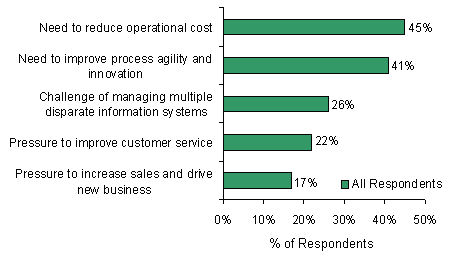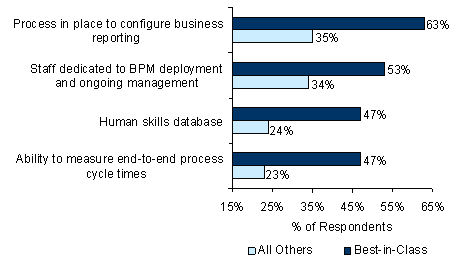Business Process Management and Beyond: The Human Factor of Process Management
How Best-in-Class companies make the most of BPM
- By Michael Lock
- December 3, 2008
by Michael Lock
The growth in the use and applicability of enterprise software has generated productivity and efficiencies for countless companies. However, as a common side effect of this expansion, some organizations are left with a confusing web of heterogeneous systems, giving them little or no visibility into their business processes. The first wave of business process management (BPM) tools provided sorely needed integration capabilities but were costly, resource intensive, and not for the technically faint of heart.
Recently, to gain even better visibility into their operational processes and deliver that visibility to the key business decision makers, organizations are examining a new generation of BPM solutions that strip away the need for programming expertise and extend BPM deployment to a broader range of users.
To learn more about how organizations are working with BPM, and how Best-in-Class organizations distinguish themselves from their competitors, Aberdeen conducted a study of BPM use. Among the findings: leveraging a wide range of organizational capabilities, Best-in-Class companies were able to markedly improve customer service and reduce waste. The report was based on feedback from 225 end-user organizations worldwide.
Although many companies still have reservations about BPM deployment, most survey respondents face an onslaught of business challenges that drive them to invest resources in a process management strategy. Particularly in light of today's volatile economy, many organizations are looking to trim the fat from their operations and drive out any unnecessary cost.
The research validates this notion by revealing that cost reductions are top of mind for business executives looking into BPM initiatives (Figure 1).

Figure 1 - Top Pressures Driving a Focus on Process Management
Source: Aberdeen Group, November 2008
Competitive Tactics for Process Management
Responding to the pressures listed in Figure 1 requires a holistic approach to process management that can’t be achieved by simply implementing a software tool. Aberdeen’s research showed that Best-in-Class companies share several common aspects of organizational maturity that provide a foundation for deployment of a formal process management strategy.
In the areas of process, organization, knowledge management, performance measurement, and technology management, Best-in-Class organizations are leveraging a range of organizational capabilities that promote smoother BPM implementation and position them to drive substantial cost reductions and process efficiencies (Figure 2).

Figure 2 - Best-in-Class Internal Capabilities for Process Management
Source: Aberdeen Group, November 2008
In today's competitive landscape, excellent business processes serve as the engine of a top performing company. The key processes that matter most to a company need to be efficient, adaptable, and perhaps most important, clearly defined. One bad link in a process workflow can lead to significant amounts of wasted time and effort. Having clearly defined and documented business processes helps avoid this waste and promotes smoother and more agile processes. Aberdeen’s research shows that Best-in-Class companies are almost twice as likely as all other companies to have these well-defined and well-documented business processes.
Another essential element of process improvement involves measuring end-to-end process cycle times. A lack of visibility into how the business is operating and performing is a major roadblock to improving efficiency. The data shows that Best-in-Class organizations are more than three times as likely as Laggards to measure their end-to-end process cycle times and other performance improvements, paving the way for substantial process efficiencies.
Operational Improvements through Better Process Management
For some companies, the value of BPM remains hard to communicate. Tools, solutions, and strategies around process management can be challenging to implement without the proper knowledge foundation and business case in place. However, companies that have implemented BPM successfully and produced demonstrable performance improvements have spread its functionality throughout several areas of the business. Best-in-Class companies in particular have shown the broadest adoption of BPM within the organization, using the ideals of process management for customer service, asset management, procurement, and sales, to name a few. Spreading this functionality and visibility to a wider segment of users has enabled Best-in-Class companies to improve performance:
Operating Cost: Best-in-Class companies drove a weighted average 26 percent year-over-year reduction in operating cost compared with a 5 percent reduction for the Industry Average and 15 percent increase for Laggard companies.
Customer Responsiveness: Best-in-Class companies achieved a weighted average 41 percent year-over-year improvement in customer responsiveness -- measured as the average response time to customer service requests -- compared with an 11 percent improvement for the Industry Average and a 2 percent decline for Laggard organizations.
Process Efficiency through Waste Reduction: Best-in-Class companies achieved a weighted average 41 percent year-over-year increase in process efficiency -- measured as a reduction in the number of manual steps in key business processes -- compared with a 12 percent improvement for the Industry Average and a 10 percent decline for Laggards.
Best-in-Class companies employed a wide variety of technologies and solutions to enable these improvements, solutions such as business activity monitoring (BAM), business intelligence (BI), and IT service management (ITSM). However, regardless of the types of technologies in use and the application of the technology, Best-in-Class companies have a common approach to BPM. This strategy encompasses a strong foundation of organizational capability to help measure, monitor, improve, and optimize their business processes for use in a wider range of applications across the company, ultimately leading to substantial operational improvements.
Michael Lock is a senior research associate in the technology markets group of Aberdeen Group. You can reach him at [email protected].